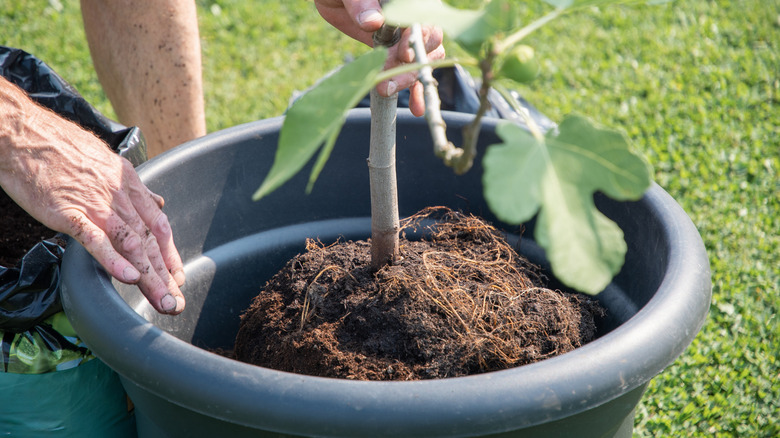The Self-Pollinating Fruit Tree Variety That's Easy To Grow In A Container
Many dwarf fruit trees are easy to grow in containers, indoors or outdoors, or both. One somewhat less common fruit tree choice is the dwarf fig, which does well in colder zones outdoors in summer but is brought inside to overwinter. There are several dwarf varieties perfect for containers, but we're recommending one that is also self-fertile and doesn't need a pollinator: the 'Brown Turkey' fig.
There are a few things a gardener should know before planting a fig tree. Though most fruit trees need plenty of sun, and figs are no exception, this cultivar can also thrive in partial shade — making it a versatile fruit tree for many gardens. Being a smaller tree, the Brown Turkey fig (Ficus carica 'Brown Turkey') is also a perfect dwarf fruit tree for a smaller yard space. Also known as the California Brown Turkey Fig, this tree performs well in warmer climates, though some fig tree experts claim it doesn't like too much humidity.
This fig tree is somewhat cold hardy and can live outdoors in USDA Zones 7-10, but growing it in a container means you can move it indoors for winter. Start with a smaller container and then repot as needed as your tree grows. When you first plant your fig tree, it will be a young tree, so a 3-7 gallon container should be fine for the first year or two. Fruit tree growers recommend a 10-15 gallon container for dwarf fruit trees when they reach their mature size, as this is a manageable size container to move indoors as needed. A plant tray on wheels makes this task much easier.
Growing the Brown Turkey Fig
Not planting pollinators is a common mistake people make when growing fruit trees. Though Brown Turkey fig trees are self-pollinating, most fruit growers agree that growing an additional pollinator tree will increase your fruit yields. A pollinator tree allows for insects like honeybees to visit the trees and transfer pollen. This process, known as cross-pollination, is necessary for some trees to set fruit. On self-pollinating trees, it can help encourage better fruit development. You can add another dwarf fig tree (like 'Celeste' or 'Little Ruby') if you wish.
Fig trees are drought-tolerant when grown in the ground, but in containers, they need regular watering since the soil will dry out more quickly. Choose a container with good drainage, and use a slightly acidic, well-draining potting soil mix to help avoid overwatering or root rot. As your Brown Turkey fig moves past the fruiting season towards winter dormancy, you can cut back on watering by about half, until spring growth starts again.
The mature size of the Brown Turkey fig is between 10-25 feet tall, but container-grown figs tend to stay much smaller. Still, you can expect your tree to get up to 8 feet tall and almost as wide, so to keep its size under control, you should prune it every year. This is best done in late winter when the tree is in its dormant season. Prune off any dead or damaged branches first. Then prune back about a third of the tree's mass, stepping back to check the shape as you prune, to keep it to a manageable size.

